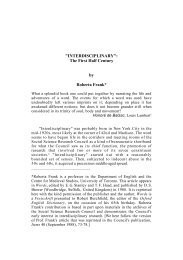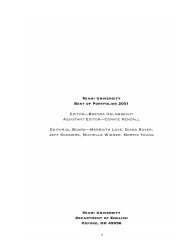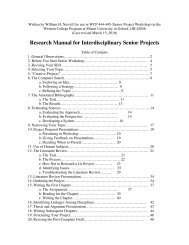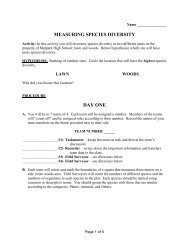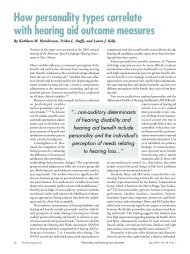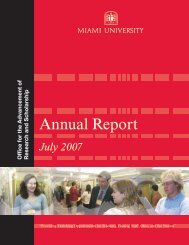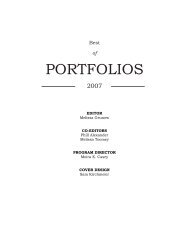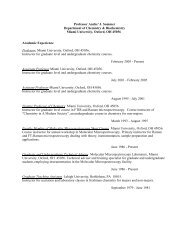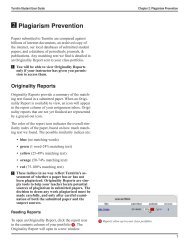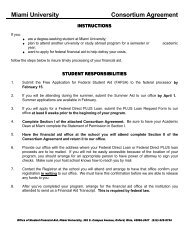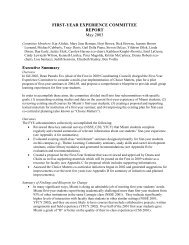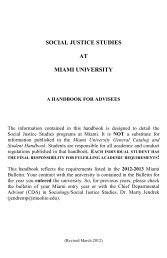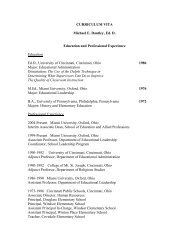The Steppes: Crucible of Eurasia - units.muohio.edu - Miami University
The Steppes: Crucible of Eurasia - units.muohio.edu - Miami University
The Steppes: Crucible of Eurasia - units.muohio.edu - Miami University
Create successful ePaper yourself
Turn your PDF publications into a flip-book with our unique Google optimized e-Paper software.
ise <strong>of</strong> the Silk Roads. In this paper, I explore historical and archaeological evidence for Xiongnu<br />
state interaction with Central Asia and with China and critique the long standing assumption that<br />
eastern steppe nomads were peripheral to or predatory upon exchange between East and West. I<br />
suggest that nascent Silk Road activities were likely a critical part <strong>of</strong> the political economy <strong>of</strong> the<br />
Xiongnu state and examine the possibility <strong>of</strong> nomads as early architects <strong>of</strong> <strong>Eurasia</strong>n trade.<br />
Jean-Luc Houle, Department <strong>of</strong> Folk Studies and Anthropology, Western Kentucky <strong>University</strong><br />
(jean-luc.houle@wku.<strong>edu</strong>)<br />
Empire and Domestic Economy: Continuity and Change in Mongolia’s Bronze and Iron Age<br />
Archaeological Landscape<br />
This paper addresses the issue <strong>of</strong> social and political change from the Bronze Age to the<br />
Iron Age Xiongnu period by investigating continuity and change in the domestic economy in the<br />
Khanuy region <strong>of</strong> north central Mongolia. My goal is to assess the nature and the degree <strong>of</strong><br />
integration <strong>of</strong> ideology, economy and politics as the region’s populace shifted from a series <strong>of</strong><br />
independent small-scale polities to part <strong>of</strong> an ‘imperial’ state. We now know that during the Late<br />
Bronze Age herders in Khanuy Valley were becoming increasingly complex largely as a result <strong>of</strong><br />
local interaction (Houle 2010). Once incorporated into the Xiongnu imperial polity, political<br />
power became markedly more centralized and the political economy more extensive. In<br />
analyzing both pre Xiongnu and Xiongnu Period situations, I focus on the internal dynamics and<br />
the external links <strong>of</strong> production, distribution, and consumption. I am mostly interested here with<br />
the changes in daily life (or lack there<strong>of</strong>) that came about when Khanuy Valley people were<br />
incorporated into a political system that was greater in scale and focused on relationships<br />
external to Khanuy Valley. As radical as some changes were under Xiongnu rule, the evidence is<br />
equally interesting for the economic continuities. Most importantly, households and communities<br />
apparently continued to be largely self-sufficient in their subsistence and utilitarian craft<br />
production.<br />
Trudy S. Kawami, Arthur M. Sackler Foundation, New York<br />
(tkawami@arthurmsacklerfdn.org)<br />
<strong>The</strong> Coiled Feline in the Iron Age <strong>Steppes</strong>: An Art Historical View<br />
<strong>The</strong> image <strong>of</strong> the coiled feline, considered a typical motif in Scythian art <strong>of</strong> the 7 th<br />
century BCE, is an art historical puzzle. It has no immediate antecedents in the art <strong>of</strong> the steppes,<br />
and the excavated examples, which range from the Crimea to northern China, are strikingly<br />
similar in style. Furthermore, they are not randomly distributed, but occur in specific regions.<br />
Even in these regions, the image is found only in elite graves and even then rarely. Objects<br />
bearing the coiled feline are not multiples like the belt and garment ornaments <strong>of</strong> the steppe<br />
peoples, but are singular works found on horses or associated with horse gear. <strong>The</strong> sudden<br />
appearance <strong>of</strong> this distinctive image, its restricted occurrence, and rapid spread across the steppes<br />
suggest that it was an intentionally created emblem associated with the horses <strong>of</strong> a limited<br />
though widespread elite.<br />
7



